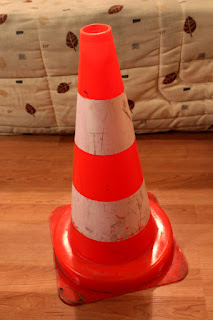Noseguards for DT longboards
Cracking the nose of your deck is really bad, and shortens its life and flex, expetially on drop through longboards. Some friends found a smart solution that can be applied also on top mounts and works really well. Here's my homemade version.
First of all you need a plastic material that can deform while keeping some resistence: the most used, working stuff are those gummy orange traffic cones, used in maintainence works on the roads. Of course there's must something else that works fine or even better, so if you know just tell me.
I cut the cone to get a flat sheet and mesured the distance between the front boltholes and the nose edge in my deck. I then cut out and shaped two strings to fit the bolts and the pivot seat in my baseplates.
Here's the result. The strings must be a bit longer than twice the distance boltholes-edge, to leave some empty space and let the gum compress and rebound without taping the deck. I added a plastic string around it to make it compress better.
Pros: it's super efficient and it can also be done on top mounts. In that case it can even be placed between the deck and the baseplate (must drill a total of 6 holes on your noseguard and it has to be longer to cover all the baseplate area) working as a shock/riser pad.
Cons: It's ugly and if you do freestyle it reduces the pop of the kicks.
I prefer this soft solution to the solid plastic or metallic ones. Those are cooler and can be hidden on the bottom of the deck, but its harder to find the right material and to work it with cheap home tools.
Also those can be much heavier and, if not well done, they transmit the shock through the bolts leadind to a cracked deck in the boltholes.
First of all you need a plastic material that can deform while keeping some resistence: the most used, working stuff are those gummy orange traffic cones, used in maintainence works on the roads. Of course there's must something else that works fine or even better, so if you know just tell me.
I cut the cone to get a flat sheet and mesured the distance between the front boltholes and the nose edge in my deck. I then cut out and shaped two strings to fit the bolts and the pivot seat in my baseplates.
Here's the result. The strings must be a bit longer than twice the distance boltholes-edge, to leave some empty space and let the gum compress and rebound without taping the deck. I added a plastic string around it to make it compress better.
Pros: it's super efficient and it can also be done on top mounts. In that case it can even be placed between the deck and the baseplate (must drill a total of 6 holes on your noseguard and it has to be longer to cover all the baseplate area) working as a shock/riser pad.
Cons: It's ugly and if you do freestyle it reduces the pop of the kicks.
I prefer this soft solution to the solid plastic or metallic ones. Those are cooler and can be hidden on the bottom of the deck, but its harder to find the right material and to work it with cheap home tools.
Also those can be much heavier and, if not well done, they transmit the shock through the bolts leadind to a cracked deck in the boltholes.










Commenti
Posta un commento